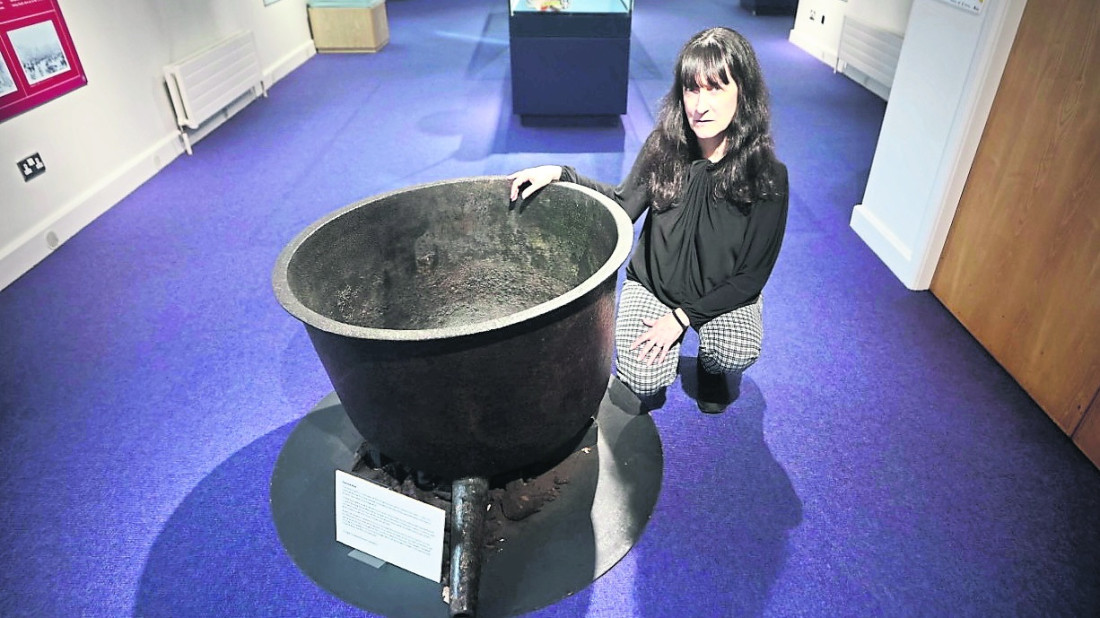By Paddy Walsh
On the site of the former workhouse in Letterkenny and within the very walls that housed the destitute and the dying, the famine ghosts roam.
They roam through a lecture in the Donegal County Museum in a building where, 180 years previously, death stalked the corridors as hunger and fever took hold without mercy.
Historian in Residence, Dr Hilary McLaughlin-Stonham is detailing the impact of the Irish Famine in Donegal – her lecture tallying with a specially produced booklet of essays she has compiled, drawing on the physical and online records that are available at the Donegal County Archives.
It’s estimated that between those who died and those who emigrated, 40,000 were lost to the county.
There could be no more appropriate location for the talk than the site of one of seven workhouses in Donegal that were constructed between 1843 and 1846 as a result of the 1838 Poor Relief Act.
Apart from Letterkenny, the other workhouses were based in Milford, Stranorlar, Glenties, Dunfanaghy, Inishowen, and Ballyshannon.
Some of those homed in larger institutions such as Glenties and Ballyshannon were described as being in a “dreadful state; the people half starved and only half clothed”. Bedding made up of dirty straw, the living and the dead lying side by side.
These workhouses offered an option to emigration but not much else.
Concerning the Letterkenny Workhouse on the High Road, there were “serious concerns” about the treatment and the manner in which the dead were buried.
In her booklet, Dr. McLaughlin highlighted the incidents of death from overcrowding and fever both inside and outside the workhouse.
Treatment of the living and dead deteriorated as death became more common, compelling the Rev. W. Harvey to raise his concerns at the way in which burials were being conducted by the workhouse authorities.
“He described a ‘lad’ named O’Donnell taking coffins on a cart after 1am to Leck graveyard in Letterkenny for burial with no documentation, relatives or ‘even a minister’ and which, if not for the moonlight, would have remained unburied.
“The way in which bodies were conducted was…revolting to every right and sacred feeling..” the Rev. Harvey insisted.
The Board of Guardians overseeing the Letterkenny workhouse resolved to change the practice but bodies continued to remain in the workhouse for up to six days without burial.
“At the onset of the Famine, Letterkenny workhouse could accommodate 500 paupers. By August 1846, the potato crop in Letterkenny showed signs of disease in every electoral division and numbers in the workhouse increased dramatically.
“Pregnant women, children and older people were the most vulnerable during the Famine and children under ten accounted for 24% of the dead. Throughout 1846 over 300 people were admitted or born in Letterkenny workhouse while a further 124 were discharged or died.”
By 1847 fever had gripped the area and the workhouse began to erect temporary sheds to accommodate 40 more fever patients which quickly filled above capacity.
The Letterkenny Relief Committee was organised the same year and was additionally funded by donations from local landlords such as John Stewart of Rockhill who donated £20, Dr McLaughlin revealed.
Meanwhile, the Union of Letterkenny, in an effort to allow the stricken to escape the conditions, facilitated the emigration of orphan girls to Australia between the years 1848 and 1850.
“The life the girls went to differed greatly from the workhouse but was not necessarily more appealing. Some orphans such as Fanny Duffy, aged 17 from Letterkenny, returned while another local girl, Nancy Curren married, had children and died in Melbourne Hospital in 1875,” the Historian in Residence recorded.
Fourteen year old Catherine Baird from Letterkenny set sail on the Lady Kennaway to Melbourne and was subsequently employed as a house servant.
She later married a ship’s steward in Bendigo in 1872 and was joined by her niece from Donegal in 1865.
In September 1849, Ellen Doherty set out with her two children, Brigid (14) and Daniel (11) from Buncrana to walk to Dublin so determined was she to leave her country of birth and the famine that had wrought so much devastation.
“They missed their boat, and clearly exhausted, Ellen refused the second boat but eventually boarded the St Vincent in 1851.”
Dr McLaughlin told her audience at the County Museum that the over-riding theme of many of the letters sent back to Donegal by the emigrants was one of homesickness.
Many newspapers of the day including the Boston based Pilot Newspaper featured advertisements from family members seeking Donegal people who never returned home.
“An advertisement was placed for Hannah Galaugher of Stranorlar by her sister and brother after she emigrated to Illinois in 1851. By 1852 they had no word of her whereabouts.”
Margaret Ann Mulgrew from Letterkenny left her husband when she arrived in St Louis in 1852. “He offered a reward of $5 for her location in 1865 ‘dead or alive’.”
Meanwhile, back home, the living were still struggling to avoid joining the dead.
And starvation and desperation, was driving the people to secure what was necessary to stay alive.
The lecture heard that as early as December 1846, small farmers in Dunfanaghy were exchanging or selling their pigs and fowl, bedclothes and fishing nets, to buy food that soon was used up.
Gaoth Dobhair was one of the least affected areas due to the presence of the landlord Lord George Hill but nearby Dungloe was another impoverished area during the years of the famine.
Small farmers in Stranorlar were said to be living in “miserable hovels in a state of degradation…often without window and chimney”.
On Arranmore Island, an American social reformer spoke of “many lying weak with hunger in dark, smoky, floorless abodes.”
On an island, where she noted, the “dying were burying the dead.”
Receive quality journalism wherever you are, on any device. Keep up to date from the comfort of your own home with a digital subscription.
Any time | Any place | Anywhere










